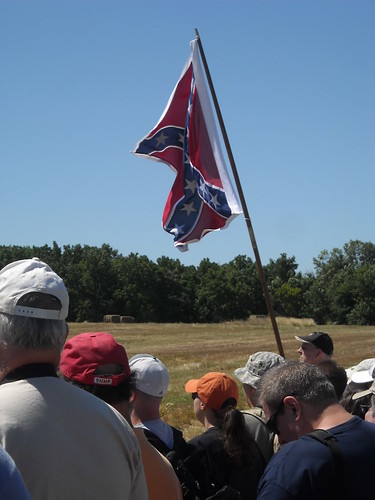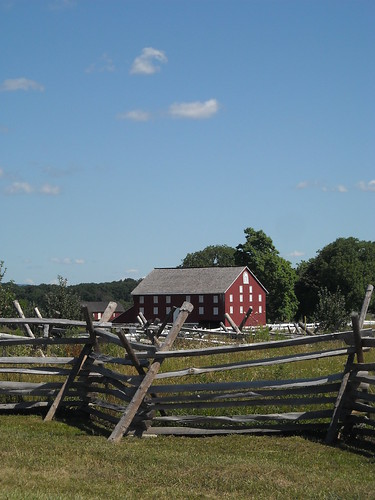 |
| What exactly did these visitors walk away remembering? |
So, what is the target that Civil War interpretation aims for? I go on programs and walks with interpreters when I'm out visiting Civil War sites. I love tours.
When I'm on a battlefield, I often witness a deep passion from the interpreter that the detailed actions of the battle are paramount. Their voices usually perk up at the nuts and bolts of battle movements and intricacies of where regiments stood, how many volleys they fired and the mechanics of war. You can't fault this personal passion, but passion alone does not simply catch like a virus. Meanings need to be facilitated, not donated to the visitor.
I went on a personal tour of a western battlefield one time with a deeply dedicated and knowledgeable historian. For two hours, he scrutinized the field as the sun waned, showing me places and describing every intricate detail of the battle occurred. I can't, for the life of me, remember a single bit of the battle action he described as he argued with the air. He held a discussion with every leading historian in absentia on the failures of their understanding of the battle. Still, I can't remember a detail of it. Not a one. I was very appreciative of the time he spent, but it was a wet towel to my appreciation of the battle landscape. That field means nothing more to me now than it did before that tour. I was never given an opportunity to explore what that place might mean to me. The goal seemed, regardless of the visitor's interests, to be imparting knowledge of tactics.
When I've visited house museums, the interpreter's passion usually rises at the mention of spoons or double-hung window sashes. And here, too, you cannot fault someone for what they personally care about. The intricacies of Victorian table manners, the strictures of 19th-century lifeways and the complexities of ornamental decoration over a fireplace often become the most talked about subject on a tour of a home. Jacob has a great story of a house museum which bucks this trend coming up soon, but in general it's all been about spoons when I've walked into a dining room of an historic home, and little about the conversations that happened over that table. The goal seems, regardless of the visitor's interests, to be imparting knowledge of the spoon.
All of this begs the question: what is history? I think every historian at some point in their career needs to wrestle with this one. If you've never done so, then you risk wandering through the profession with no bearings. So, what is it?
To me, history's definition is short and sweet:
History is ideas put into action by men on a landscape.
These four key elements all are present in any historical event. Take Seneca Falls in 1848: a Declaration of Sentiments for equality was signed by 68 women and 32 men in the Wesleyan Chapel. Or take Utah Beach in 1944: an assault on Fortress Europe by average men to topple the oppressive Nazi regime and ensure freedom in Europe. Whether the action is a grand military expedition or the flick of a pen on paper, mankind acting out ideas and ideals on a landscape encapsulates history in my mind.
But the passion for tactics or the passion for the spoon fails this test quite handily. Spoons or molding or curtains alone have no people and no ideas, and thereby little relevance. Tactics taken alone have no ideas and only faceless, shapeless groups of bodies, and thereby little relevance.
 |
| Who marched across this landscape? Men or Armies? |
No. They care about that spot because an academic, an aloof professor of rhetoric, against what we might expect from a college professor, ordered his men to charge down the slope of Little Round Top, helping to ensure United States victory at Gettysburg and thereby a nation preserved and freedom for 4 million in bondage.
The tactic is only the context. The story and route to broad relevance lives within the man and the ideas / ideals his actions embodied.
In the end the question is simple: do we want the American public to know about these places or understand them? Knowing is being able to repeat rote fact. It is memorization of faceless facts and figures, the recitation of lists of dead white men in specific orders, the rattling off of cold and motionless dates. In short, knowing is the reason why every student in high school who hates history hates it.
Understanding is feeling and processing the place, the ground and the men who acted there, then caring about that place for your own personal reason. Certainly, tactical discussion is important, but its primary function is as a framework inside of which the men of a battlefield lived. The experiences of those men are what resonate with a modern visitor. Don't believe me? Just ask a fellow visitor what moved them most after you attend a program.
We often hear admonitions to sprinkle in human interest stories into programs and interpretive products. But this is, IMHO, the wrong impulse. Tactics are what should be sprinkled in; the core is human interest, where the personal relevance of the American audience is to be found.
Jake quoted a great piece of Freeman Tilden's Interpreting Our Heritage recently, which works as an excellent coda here:
The battlefield of our great fratricidal American war is not merely a place of strategy and tactics: not a place where regiments moved this way and that like checkers on a board; not merely a spot where something was decided that would lead to another decision. It is a place of the thoughts and acts of men, of their ideals and memories... a place of people, not armies.
Time to play Devil's Advocate again. I agree with the VAST majority of what you say, however (pregnant pause), can you have one without the other? Does Chamberlain have the cache that he currently possesses w/o posting those colors, refusing the front, and charging down that hill? If he did none of that would he become a nondescript colonel much in the vein of William Lowrance who is a mere footnote in history? In my opinion this is a chicken and egg issue. Tactics dictate the stories (in a general sense) and the people dictate the events (in a general sense).
ReplyDeleteI also meant to add ...
ReplyDeleteIf the people visiting a battlefield have no idea about the action that took place within their range of vision, do the peoples' actions have nearly as much meaning?
John, I hate that this is what is jumping out at me the most, but - people, not men. (I understand you're using it in the poetic, "mankind" sense - but people, not men.)
ReplyDeleteBeyond that, I largely agree with you on this. The cemetery and monument programs were usually my favorites at GNMP precisely because they tended to focus more on the people rather than tactics.
I also love that you brought up Chamberlain, although part of why we remember him is that this academic and later politician effectively shaped the memory of the battle and promoted his own heroism. But still, actions by people about ideas.
Your experience at the unnamed western battlefield is one of my worst fears of creating and I know I have done it. Depending on the size of the group, I think it comes down to reading your audience. I am lucky enough to never lead a tour of more than three people at a time and I feel I am getting better at gauging how much visitors care about the tactics or the mechanics of the weapons. Regardless, I have found that centering tours on people and progressing the story of the battle around them works best. At Gettysburg, Chamberlain is definitely popular, but Sickles is a crowd pleaser as well. By giving a lot of attention to Sickles, I end up telling a good portion of the battle since he was so influential on Day 2’s events.
ReplyDelete